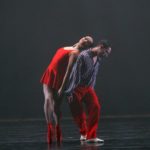By Elizabeth Kramer for The Courier-Journal
September 10, 2016
Increasingly in recent years, dance performances have become events at notable art museums such as the Museum of Modern Art.
But choreographers have long found inspiration in and ways to work with visual artists. The Louisville Ballet’s artistic and executive director Robert Curran made his intentions to do that nearly two years ago in a new look for George Balanchine’s “Square Dance” that included work by Louisville-based artist Letitia Quesenberry.
Curran’s first personally choreographed piece, “How They Fade,” took that collaboration to a new level in a dance Friday on the stage of the Kentucky Center’s Whitney Hall.
But that melding of design and dance also figured into the company’s first performance of choreographer Twyla Tharp’s 1986 work “In the Upper Room,” with looks dominated by designer Norma Kamali’s costumes of stripped fabric, red-toe shoes and other red trimmings. Accompanying these contemporary works was Balanchine’s “Theme and Variations,” with stage and costumes that strongly hinted at Art Deco and choreography that showcased grand architecture combined with rudimentary classical steps that grew ever more complicated.
Curran’s “How They Fade” dance against the haunting music of the San Francisco band Yassou playing with the Louisville Orchestra melded with indistinct images created by Quesenberry and with soft colors that blended together and were projected on a huge screen. Those misty yearning they conjured against Curran’s intensely physical and sometimes athletic movements suggested an idea of inner struggle at work.

